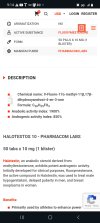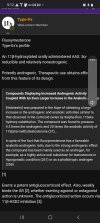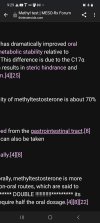Type-IIx
Member
Fluoxymesterone
Type-IIx’s profile
An 11β-hydroxylated orally administered AAS. 5α-reducible and relatively nonestrogenic.
Potently androgenic. Therapeutic use obtains efficacy from this feature of its design.
Exerts a potent antiglucocorticoid effect. Also, weakly binds the GR [2], whether exerting agonist or antagonist action is unknown. The antiglucorticoid action occurs via 11β-HSD2 inhibition [3]:
11β-HSD2: enzyme that controls the oxidation of cortisol. Its inhibition leads to glucocorticoid-mediated MR activation, potassium excretion, sodium and water retention, and increased blood pressure (Ferrari, 2010; Ferrari et al., 2001; Serra et al., 2002) [3]. Halotestin competitively inhibits 11β-HSD2, thereby leading to glucocorticoid-mediated MR activation [3]. AAS that inhibit this enzyme may aggravate atherosclerosis via MR activation and inflammatory processes in the vascular endothelium (Glazer, 1991; Thompson et al., 1989) [3].
Mechanisms in promoting aggression/strength and anti-adpogenic/hardening effects
Mechanism in aggression/strength: competitive inhibition of cortisol oxidation [3]. Compared with cortisol, fluoxymesterone ~3-5x less efficiently converted to its 11-oxo form, resembling the conversion of dexamethasone [3]. The presence of an 11-oxo group tends to promote tissue-specific cortisol modulation which may lead to greater visceral fat loss and increased glycogen deposition.
Mechanism in anti-adipogenic/lipolytic ("hardening") effect: { Link to Compounds: Anti-adipogenic mechanisms }
… [analogous to DHT] inhibits adipogenic differentiation of hMSCs and human preadipocytes through an AR-mediated pathway, but it does not affect the proliferation of either hMSCs or preadipocytes. Androgen effects on fat mass represent the combined effect of decreased differentiation of fat cell precursors, increased lipolysis, and reduced lipid accumulation. [4].
Practical
Used frequently by strength athletes for its potent raw strength/power augmentation ("peaking"). Its relative toxicity is a consideration for dose/duration. A typical course may be 30mg daily x 4 weeks, with 40-60mg a day the last few days before competition. May also be used during a strength cycle in a pulsed fashion, to peak for PR/PB attempts. Bodybuilders use frequently for its "hardening" (anti-adipogenic) effect at the end of a prep cycle, typically after cutting out injectables. Doses may scale up based on body mass. May be used by combat athletes prior to a fight for its aggression-promoting effects and for focus/clarity (anecdotally), though { Link to Cheque drops/mibolerone } may be preferred under the assumption of its being relatively undetectable in urine post-fight (anecdotally).
Practical consequences
Impaired corticosteroid metabolism and activation of minerolocorticoid receptor (MR) has been associated with cardiovascular disease (Briet and Chiffrin, 2010; Hadoke et al., 2009; Lastra et al., 2010) [3].
__________
References:
[1] Vida, J. Androgens and anabolic agents (1969).
[2] Houtman, C. J., Sterk, S. S., van de Heijning, M. P. M., Brouwer, A., Stephany, R. W., van der Burg, B., & Sonneveld, E. (2009). Detection of anabolic androgenic steroid abuse in doping control using mammalian reporter gene bioassays. Analytica Chimica Acta, 637(1-2), 247–258. doi:10.1016/j.aca.2008.09.037
[3] Furstenberger, C., Vuorinen, A., Da Cunha, T., Kratschmar, D. V., Saugy, M., Schuster, D., & Odermatt, A. (2012). The Anabolic Androgenic Steroid Fluoxymesterone Inhibits 11 -Hydroxysteroid Dehydrogenase 2-Dependent Glucocorticoid Inactivation. Toxicological Sciences, 126(2), 353–361. doi:10.1093/toxsci/kfs022
[4] Gupta, V., Bhasin, S., Guo, W., Singh, R., Miki, R., Chauhan, P., … Jasuja, R. (2008). Effects of dihydrotestosterone on differentiation and proliferation of human mesenchymal stem cells and preadipocytes. Molecular and Cellular Endocrinology, 296(1-2), 32–40. doi:10.1016/j.mce.2008.08.019
Type-IIx’s profile
An 11β-hydroxylated orally administered AAS. 5α-reducible and relatively nonestrogenic.
Potently androgenic. Therapeutic use obtains efficacy from this feature of its design.
[1]Compounds Displaying Increased Androgenic Activity Coupled With An Even Larger Increase in the Anabolic Activity
[Halotestin] was prepared in the hope of obtaining a large increase in the androgenic and anabolic activities similar to that observed in the corticoid series by 9alpha-fluro 11beta-hydroxy substitution. The compound was found to possess 9.5 times the androgenic and 20 times the anabolic activity of 17alpha-methyltestosterone (37)...
In spite of the fact that fluoxymesterone has a favorable anabolic-androgenic ratio, due to the strong androgenic effect the compound has been mainly used as an androgen, for example, as a highly active oral substitute for testosterone in hypogonadic condition (267) or as a phallotropic androgen (268).
Exerts a potent antiglucocorticoid effect. Also, weakly binds the GR [2], whether exerting agonist or antagonist action is unknown. The antiglucorticoid action occurs via 11β-HSD2 inhibition [3]:
[3]Whereas oxymetholone, oxymesterone, danazol, and testosterone showed medium inhibitory potential, fluoxymesterone was a potent inhibitor of human 11β-HSD2 (half-maximal inhibitory concentration [IC(50)] of 60-100nM in cell lysates; IC(50) of 160nM in intact SW-620, and 530nM in MCF-7 cells). Measurements with rat kidney microsomes and lysates of cells expressing recombinant mouse 11β-HSD2 revealed much weaker inhibition by the AAS tested, indicating that the adverse effects of AAS-dependent 11β-HSD2 inhibition cannot be investigated in rats and mice. Furthermore, we provide evidence that fluoxymesterone is metabolized to 11-oxofluoxymesterone by human 11β-HSD2. Structural modeling revealed similar binding modes for fluoxymesterone and cortisol, supporting a competitive mode of inhibition of 11β-HSD2-dependent cortisol oxidation by this AAS. No direct modulation of mineralocorticoid receptor (MR) function was observed. Thus 11β-HSD2 inhibition by fluoxymesterone may cause cortisol-induced MR activation, thereby leading to electrolyte disturbances and contributing to the development of hypertension and cardiovascular disease.
11β-HSD2: enzyme that controls the oxidation of cortisol. Its inhibition leads to glucocorticoid-mediated MR activation, potassium excretion, sodium and water retention, and increased blood pressure (Ferrari, 2010; Ferrari et al., 2001; Serra et al., 2002) [3]. Halotestin competitively inhibits 11β-HSD2, thereby leading to glucocorticoid-mediated MR activation [3]. AAS that inhibit this enzyme may aggravate atherosclerosis via MR activation and inflammatory processes in the vascular endothelium (Glazer, 1991; Thompson et al., 1989) [3].
Mechanisms in promoting aggression/strength and anti-adpogenic/hardening effects
Mechanism in aggression/strength: competitive inhibition of cortisol oxidation [3]. Compared with cortisol, fluoxymesterone ~3-5x less efficiently converted to its 11-oxo form, resembling the conversion of dexamethasone [3]. The presence of an 11-oxo group tends to promote tissue-specific cortisol modulation which may lead to greater visceral fat loss and increased glycogen deposition.
Mechanism in anti-adipogenic/lipolytic ("hardening") effect: { Link to Compounds: Anti-adipogenic mechanisms }
… [analogous to DHT] inhibits adipogenic differentiation of hMSCs and human preadipocytes through an AR-mediated pathway, but it does not affect the proliferation of either hMSCs or preadipocytes. Androgen effects on fat mass represent the combined effect of decreased differentiation of fat cell precursors, increased lipolysis, and reduced lipid accumulation. [4].
Practical
Used frequently by strength athletes for its potent raw strength/power augmentation ("peaking"). Its relative toxicity is a consideration for dose/duration. A typical course may be 30mg daily x 4 weeks, with 40-60mg a day the last few days before competition. May also be used during a strength cycle in a pulsed fashion, to peak for PR/PB attempts. Bodybuilders use frequently for its "hardening" (anti-adipogenic) effect at the end of a prep cycle, typically after cutting out injectables. Doses may scale up based on body mass. May be used by combat athletes prior to a fight for its aggression-promoting effects and for focus/clarity (anecdotally), though { Link to Cheque drops/mibolerone } may be preferred under the assumption of its being relatively undetectable in urine post-fight (anecdotally).
Practical consequences
Impaired corticosteroid metabolism and activation of minerolocorticoid receptor (MR) has been associated with cardiovascular disease (Briet and Chiffrin, 2010; Hadoke et al., 2009; Lastra et al., 2010) [3].
__________
References:
[1] Vida, J. Androgens and anabolic agents (1969).
[2] Houtman, C. J., Sterk, S. S., van de Heijning, M. P. M., Brouwer, A., Stephany, R. W., van der Burg, B., & Sonneveld, E. (2009). Detection of anabolic androgenic steroid abuse in doping control using mammalian reporter gene bioassays. Analytica Chimica Acta, 637(1-2), 247–258. doi:10.1016/j.aca.2008.09.037
[3] Furstenberger, C., Vuorinen, A., Da Cunha, T., Kratschmar, D. V., Saugy, M., Schuster, D., & Odermatt, A. (2012). The Anabolic Androgenic Steroid Fluoxymesterone Inhibits 11 -Hydroxysteroid Dehydrogenase 2-Dependent Glucocorticoid Inactivation. Toxicological Sciences, 126(2), 353–361. doi:10.1093/toxsci/kfs022
[4] Gupta, V., Bhasin, S., Guo, W., Singh, R., Miki, R., Chauhan, P., … Jasuja, R. (2008). Effects of dihydrotestosterone on differentiation and proliferation of human mesenchymal stem cells and preadipocytes. Molecular and Cellular Endocrinology, 296(1-2), 32–40. doi:10.1016/j.mce.2008.08.019





